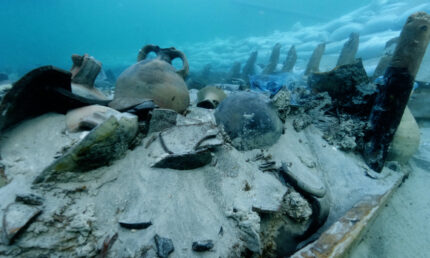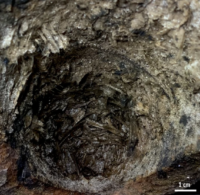 The first in-depth analysis of the cargo of the 4th century Roman shipwreck found off the coast of Mallorca in 2019 has been published in the journal Archaeological and Anthropological Sciences. Researchers took a multipronged approach to the analysis, using petrographic analysis to determine the origin of the amphorae, residue analysis to determine their contents and wood and plant analysis on the ship’s hold. They were able to determine that the boat likely departed from Cartagena in southeastern Spain carrying a cargo of fish sauce, olive oil and wine in four different types of amphora, including one that hasn’t been found anywhere else before. It has been named a Ses Fontanelles I amphora after the find site.
The first in-depth analysis of the cargo of the 4th century Roman shipwreck found off the coast of Mallorca in 2019 has been published in the journal Archaeological and Anthropological Sciences. Researchers took a multipronged approach to the analysis, using petrographic analysis to determine the origin of the amphorae, residue analysis to determine their contents and wood and plant analysis on the ship’s hold. They were able to determine that the boat likely departed from Cartagena in southeastern Spain carrying a cargo of fish sauce, olive oil and wine in four different types of amphora, including one that hasn’t been found anywhere else before. It has been named a Ses Fontanelles I amphora after the find site.
 Because the ship is exceptionally well-preserved, many painted inscriptions (tituli picti, on the exterior of the amphorae have survived. They identify the manufacturers, Ausonius et Alunni, and the contents: Liq Fos, short for liquamen flos (flowers of liquamen). At the time this ship was transporting goods, liquamen was a fish sauce distinct from garum, the fermented fish condiment that was ubiquitous in Roman repasts. (From the 5th century the two would become synonymous.)
Because the ship is exceptionally well-preserved, many painted inscriptions (tituli picti, on the exterior of the amphorae have survived. They identify the manufacturers, Ausonius et Alunni, and the contents: Liq Fos, short for liquamen flos (flowers of liquamen). At the time this ship was transporting goods, liquamen was a fish sauce distinct from garum, the fermented fish condiment that was ubiquitous in Roman repasts. (From the 5th century the two would become synonymous.)
 Fish sauces were produced in large-scale fish processing centers all long the Mediterranean basin. Spain dominated the trade in the western empire in the 1st and 2nd centuries. Spanish garum amphorae have been found from northern Africa to Hadrian’s Wall. We know from the large number of amphorae found in the homes and commercial establishments of Pompeii that garum was the most popular with about a quarter of the amphorae containing garum. Liquamen was the second most popular.
Fish sauces were produced in large-scale fish processing centers all long the Mediterranean basin. Spain dominated the trade in the western empire in the 1st and 2nd centuries. Spanish garum amphorae have been found from northern Africa to Hadrian’s Wall. We know from the large number of amphorae found in the homes and commercial establishments of Pompeii that garum was the most popular with about a quarter of the amphorae containing garum. Liquamen was the second most popular.
The analysis of the ichthyofauna has contributed to understand that this fish sauce was basically prepared with small engraulidae particularly anchovies but with presence of sardine. It is possible that also a, so far, invisible cargo occupied part of the space in the galley (Munar Llabrés et al. 2022). These products were carefully stowed in the hold of the merchant ship using vine shoots and herbaceous plants as dunnage for protection.